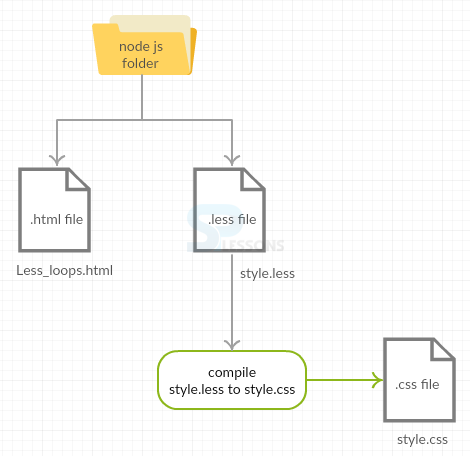 Introduction
Introduction
This chapter discusses about Less loops and its uses. Further, the main scheme of Less loops along with an example is presented.
 Description
Description
The various iterative/loop structures can be created by combining Pattern Matching and Guard Expressions in Less.
Below snippet code demonstrates the main scheme of Less Loops.
 Example 1
Example 1
[c]
.loop(@counter) when (@counter > 0) {
.loop((@counter - 1)); // next iteration
width: (5px * @counter); // code for each iteration
}
div {
.loop(6); // launch the loop
}
[/c]
 Result
Result
[c]
div {
width: 5px;
width: 10px;
width: 15px;
width: 20px;
width: 25px;
width: 30px;
}
[/c]
 Example 2
Example 2
Below example demonstrates the use of recursive loop to generate CSS grid classes.
[c]
.generate-columns(2);
.generate-columns(@n, @i: 1) when (@i =< @n) {
.column-@{i} {
width: (@i * 100% / @n);
}
.generate-columns(@n, (@i + 1));
}
[/c]
 Result
Result
[c]
.column-1 {
width: 25%;
}
.column-2 {
width: 100%;
}
[/c]
 Example 3
Example 3
Below example demonstrates the use of Less Loops.
 Conceptual
figure
Conceptual
figure
 Step 1
Step 1
Create a simple HTML file in Nodejs folder as shown below.
Less_loops.html
[c]
<html>
<head>
<link rel="stylesheet" href="style.css" type="text/css" />
</head>
<body>
<div class="cont">
<h2>LESS CSS Tutorials</h2>
<p>Less Loops is awesome.</p>
</div>
</body>
</html>
[/c]
 Step 2
Step 2
Create a LESS file in the same Nodejs folder as shown below.
style.less
[c]
h2{
color: #0000FF;
}
.cont(@count) when (@count > 0) {
.cont((@count - 1));
width: (30px * @count);
}
div {
.cont(10);
}
[/c]
 Step 3
Step 3
Compile the above less file in command prompt by using the following command.
[c]lessc style.less style.css[/c]
 Step 4
Step 4
By compiling the above less file, it automatically generates the following CSS file.
style.css
[c]
h2 {
color: #0000FF;
}
div {
width: 30px;
width: 60px;
width: 90px;
width: 120px;
width: 150px;
width: 180px;
width: 210px;
width: 240px;
width: 270px;
width: 300px;
}
[/c]
 Result
Result
 Key Points
Key Points
- The Pattern matching and Guard expression are the two important things to create the Less loop.
 Programming
Tips
Programming
Tips
- Make sure that both the HTML and LESS files are created in the same node js folder.
- Check all the required changes in the coding before running the application.





